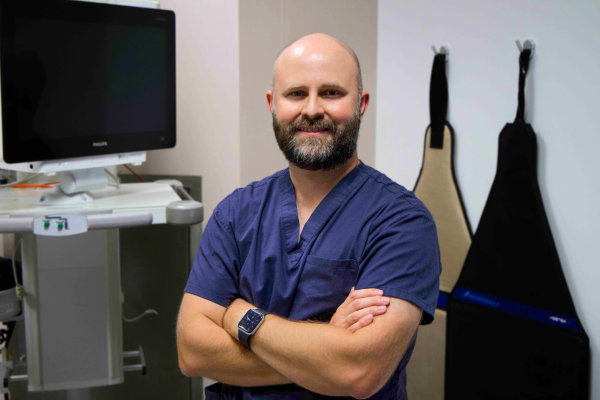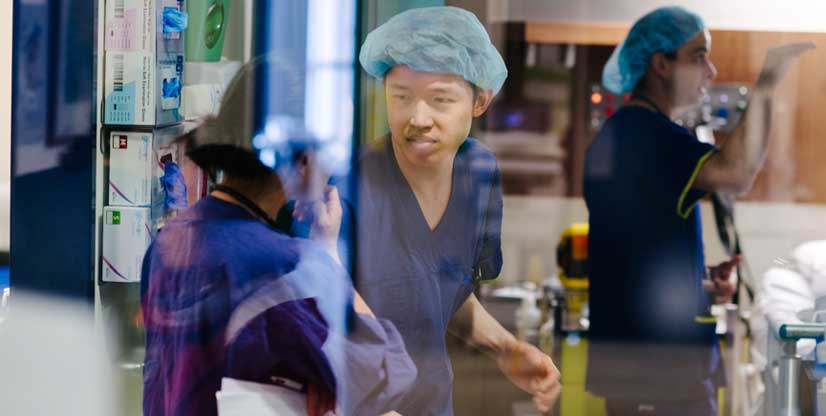About
A day in the life of an ICU physio: Meet Tom Rollinson
- Home
- About
- Latest news
- A day in the life of an ICU physio: Meet Tom Rollinson

8 September 2025
For World Physio Day (8 September), we spoke with Tom Rollinson, Clinical Lead Physiotherapist in Austin Health’s Intensive Care Unit (ICU).
Tom has been part of Austin Health since 2012 and also works in clinical research and workforce development within the Physiotherapy Department.
Tom shares what a day in the life looks like for an ICU physio, the challenges and rewards of working with the sickest patients in the hospital, and how physiotherapy plays a vital role in recovery.
What does a typical day look like for you as a physiotherapist in ICU?
Our day begins with a short multidisciplinary handover meeting. The night team updates the doctors, nurses, and physiotherapists about how patients have gone overnight. From there, we make a plan for each patient’s day, coordinating with nurses to fit physiotherapy sessions around tests, scans, and other treatments. We usually start with patients needing respiratory treatments, often those with spinal cord injuries or neuromuscular diseases, because these interventions may need to be spaced throughout the day. We also respond to patients with significant respiratory deterioration on the ward, using a critical care physiotherapy outreach model, a model we are hoping to expand further. Afterward, we focus on rehabilitation, which can involve getting patients out of bed, standing, walking, cycling – we have a special bike for in-bed use, and sitting out, even with all the lines, drains, and monitoring equipment attached. Once clinical priorities are managed, we turn to research and quality improvement projects, and support staff training through simulation and bedside teaching.
What role does physiotherapy play in helping critically ill patients recover?
Physiotherapy is central to recovery, physically and cognitively. Patients in ICU are often bed-bound, which puts them at risk of severe weakness and delirium. Simple but powerful interventions like waking up, getting out of bed, sitting upright, walking, and engaging with the ICU team and their families can help patients feel more human, restore function, support cognition, and even reduce ICU and hospital length of stay. Our role also includes assessing patients on ventilators and guiding safe, timely weaning from mechanical ventilation.
What are some of the biggest challenges of working in ICU?
The ICU cares for the sickest patients in the hospital, and they can deteriorate quickly. Physiotherapists need the skills to monitor patients closely and deliver safe, effective treatments under constantly changing circumstances. It’s a fast-paced and often emotional environment. But being part of such a highly skilled, collaborative team makes it a stimulating and rewarding place to work.
What is the most rewarding part of your career? Can you share a moment or story where you felt proud to be an ICU physio?
Some of the most rewarding moments are when former patients return to visit us, sharing their recovery and that they’ve gone home, back to work, and back to life. But perhaps the proudest period of my career was during the COVID pandemic. I helped lead our physiotherapy team in establishing a physio-led prone positioning team, delivering a vital, life-saving treatment: carefully turning critically ill patients onto their front and back to improve oxygenation. It was our opportunity to “do our bit” to support the ICU team through an unprecedented surge in patients with severe respiratory failure.
What’s something people might be surprised to learn about physiotherapy in ICU?
Many people are surprised to discover that physiotherapists even work in ICU! Even more surprising is that we deliver rehabilitation and respiratory treatments to patients who are still critically unwell and reliant on life support. Perhaps also surprisingly, patients themselves are often eager to get moving, to sit up, stand, and take their first steps again. With a careful and considered approach, ICU physiotherapists make that possible.


